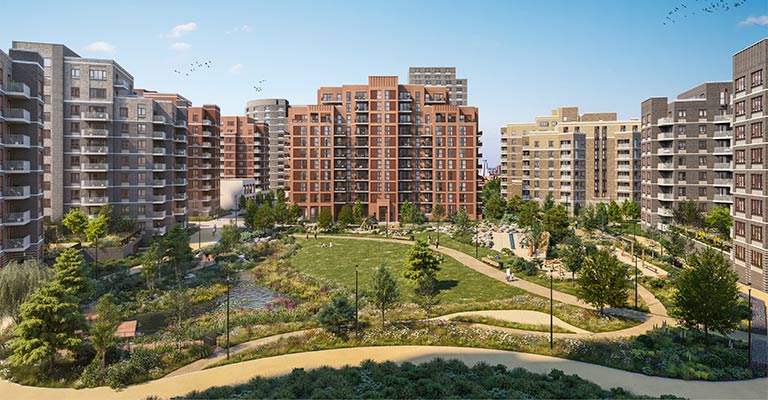As environmental awareness continues to grow, sustainable living has become a priority for many Londoners. The city is responding with a range of eco-friendly homes and communities designed to reduce environmental impact while enhancing the quality of life for residents. Whether you’re a homeowner, renter, or investor, understanding the sustainable living options in London can help you make informed choices that benefit both the environment and your wallet. Here’s a guide to sustainable living in London, highlighting eco-friendly homes and communities across the city according to estate agents in London.
1. The Rise of Eco-Friendly Homes in London
Sustainable Building Practices
- Energy-Efficient Design: Modern eco-friendly homes in London are designed with energy efficiency in mind. This includes features like high-quality insulation, triple-glazed windows, and energy-efficient lighting and appliances. These homes are built to minimise heat loss and reduce energy consumption, resulting in lower utility bills and a smaller carbon footprint.
- Renewable Energy Integration: Many sustainable homes incorporate renewable energy sources, such as solar panels, ground-source heat pumps, and green roofs. These systems reduce reliance on fossil fuels and contribute to a more sustainable energy grid.
- Sustainable Materials: Builders are increasingly using sustainable and locally sourced materials to reduce the environmental impact of construction. This includes the use of recycled materials, timber from certified forests, and low-impact concrete. Sustainable homes also focus on reducing waste during construction and throughout the home’s lifecycle.
Passive House Standards
- What is a Passive House? Passive House (Passivhaus) is a rigorous, voluntary standard for energy efficiency in buildings, resulting in ultra-low energy homes that require little energy for heating or cooling. London has seen a growing number of homes built to Passive House standards, offering residents exceptional energy efficiency and comfort.
- Benefits of Passive House: Homes built to Passive House standards typically achieve a 90% reduction in heating and cooling energy requirements compared to conventional buildings. This not only reduces environmental impact but also leads to significant cost savings for homeowners and tenants.
2. Notable Eco-Friendly Communities in London
BedZED (Beddington Zero Energy Development)
- Overview: BedZED, located in Sutton, South London, is the UK’s first large-scale, mixed-use sustainable community. Developed in 2002, BedZED was designed to promote a low-carbon lifestyle, featuring energy-efficient homes, renewable energy systems, and sustainable transport options.
- Sustainability Features: BedZED’s homes are built with thick insulation, solar panels, and triple-glazed windows to maximise energy efficiency. The community also has a combined heat and power (CHP) plant powered by waste wood, which provides heating and electricity. Residents are encouraged to adopt sustainable transport options, such as walking, cycling, and car-sharing.
- Community and Lifestyle: BedZED fosters a strong sense of community, with shared gardens, green spaces, and communal areas that encourage social interaction. The development also includes office spaces, shops, and a community centre, making it a self-sufficient neighbourhood.
The Green Quarter (Southall)
- Overview: The Green Quarter in Southall, West London, is one of the capital’s most ambitious regeneration projects, transforming a former industrial site into a vibrant, sustainable community. The development aims to create a low-carbon, nature-rich environment with a focus on green spaces and biodiversity.
- Sustainability Features: The Green Quarter incorporates energy-efficient homes, extensive green roofs, and renewable energy sources. The development also includes over 13 acres of parks and wetlands, designed to support local wildlife and provide residents with access to nature. The Green Quarter’s design promotes sustainable transport, with easy access to public transport and cycling routes.
- Community and Lifestyle: The Green Quarter is designed to be a vibrant, mixed-use community, with residential, commercial, and leisure spaces. The development includes amenities such as shops, cafes, and community centres, all designed to promote sustainable living and foster a strong sense of community.
Greenwich Millennium Village
- Overview: Greenwich Millennium Village, located on the Greenwich Peninsula, is a pioneering example of sustainable urban living. The development is part of a wider regeneration project on the peninsula, aiming to create a sustainable community with a focus on energy efficiency, green spaces, and sustainable transport.
- Sustainability Features: Homes in Greenwich Millennium Village are built to high energy efficiency standards, with features such as solar panels, energy-efficient lighting, and rainwater harvesting systems. The development includes extensive green spaces, including parks, gardens, and a lake, designed to enhance biodiversity and provide residents with access to nature.
- Community and Lifestyle: The development offers a range of amenities, including schools, shops, and healthcare facilities, making it a self-sufficient community. Sustainable transport options, such as cycling paths, pedestrian-friendly streets, and access to public transport, are integral to the development’s design.
3. Sustainable Transport Options in London
Cycling and Walking
- Cycling Infrastructure: London is investing heavily in cycling infrastructure, with new cycle lanes, bike-sharing schemes, and cycle-friendly routes being developed across the city. Areas like Hackney, Camden, and Richmond are particularly known for their cycling-friendly environments. Cycling not only reduces carbon emissions but also promotes health and well-being.
- Walkable Neighbourhoods: Many of London’s eco-friendly communities are designed to be walkable, with amenities, schools, and public transport within easy reach. Walkable neighbourhoods reduce the need for car travel, lower carbon emissions, and contribute to a healthier lifestyle.
Public Transport
- Electric Buses: London is expanding its fleet of electric and hybrid buses, reducing the carbon footprint of public transport. Areas with good access to electric bus routes are becoming more desirable for eco-conscious residents.
- Low Emission Zones: London’s Ultra Low Emission Zone (ULEZ) is expanding, encouraging the use of low-emission vehicles and public transport. Living in or near low emission zones can be a key factor for residents who prioritise air quality and sustainable living.
- How to Make Your Home Much Greener
Energy-Efficiency Additions Insulation:
The best ways to begin saving energy within your home are to add insulation. This includes walls, roofs, and even floors, to install double or triple-glazed windows.
Heating Systems: Upgrading to an energy-efficient heating system, such as condensing boilers or heat pumps, can dramatically reduce your carbon footprint. Then there’s also smart thermostats, which will help optimise energy usage by allowing you to regulate heating remotely.
Renewable Energy Solutions
Solar Panels: Installing solar panels on your roof is another way to generate renewable, clean energy. These panels are, in their own way, a good investment; although the initial investment may be quite high, the return comes by way of government incentives and savings on energy bills in the long run.
Green energy providers: You can further cut down your home’s carbon footprint by switching to a green energy provider sourcing its electricity from renewables. Most of the green energy providers are offering tariffs that help to contribute funding toward renewable projects.
Water Conservation
Rainwater harvesting: With a rainwater harvesting system, you have ample opportunity to collect rainwater for irrigation purposes in the garden, flushing toilets, and other non-potable uses. This reduces your reliance on mains water and cuts down your water bills.
Low-Flow Fixtures: Again, the key is to install low-flow taps and showerheads/toilets that function satisfactorily. Installation is very simple and can have a very big impact on the total household water consumption.
- Eco-Friendly Property Investment
Sustainable Homes Demand
Emerging demand: As people are becoming more concerned about the environment, demand for eco-friendly homes rises. Properties with an eco-friendly attribute will have a premium price, particularly in neighbourhoods and areas with good communities and transport links.
Long-term value: Owning a sustainable property can save owners money for years to come; from reduced utility bills, to possible tax incentives, to increased property values. In the future, homes with efficient energy features and renewable energy systems will probably be in demand as energy costs increase and environmental regulations become firmer.
Green Certifications
BREEAM: The Building Research Establishment Environmental Assessment Method is a well-established and leading sustainability assessment method for buildings. Homes that achieve a high BREEAM rating are recognized for their environmental performance, therefore giving them more value in the eyes of eco-conscious buyers.
EPC Ratings: The ratings vary from A, the most efficient, to G, the worst. The properties that have higher ratings will have lesser impact on the environment and are more energy-efficient, hence more attractive to prospective purchasers or tenants.
Conclusion
London is quickly becoming an easy city in which to live a sustainable life, with more eco-friendly houses and communities enabling their residents to live in harmony with the environment. From energy-efficient homes, via sustainable transport options, to green and thriving sustainable communities, London is at the forefront of the eco-friendly living movement.
Whether you are looking to buy, sell, or invest in a home, factoring in the home’s sustainability can provide long-term financial benefits and help reduce your environmental footprint. With sustainable living becoming an increasingly large concern, it is likely that eco-friendly properties in London will continue to rise in demand, therefore being an excellent choice for the future.





